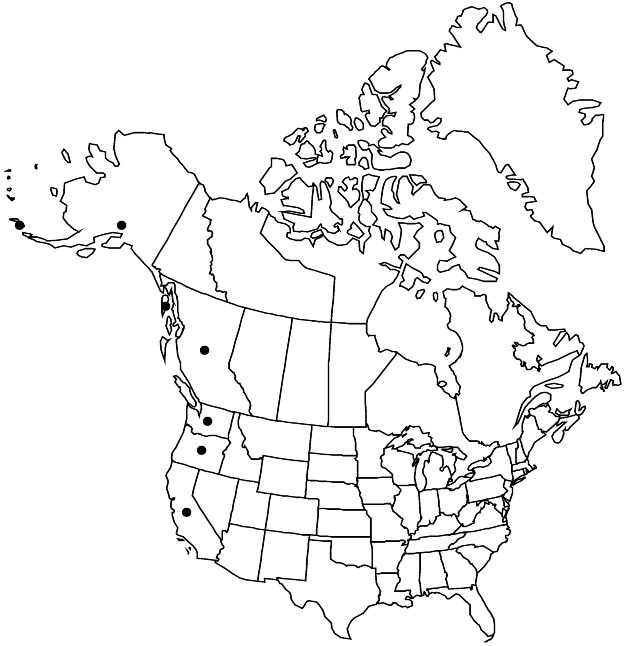Difference between revisions of "Sagina maxima"
Mem. Amer. Acad. Arts, n. s. 6: 382. 1858.
FNA>Volume Importer |
RevisionBot (talk | contribs) m (Bot: Adding category Revised Since Print) |
||
| (5 intermediate revisions by 3 users not shown) | |||
| Line 6: | Line 6: | ||
|place=6: 382. 1858 | |place=6: 382. 1858 | ||
|year=1858 | |year=1858 | ||
| + | }} | ||
| + | |special_status={{Treatment/ID/Special_status | ||
| + | |code=F | ||
| + | |label=Illustrated | ||
}} | }} | ||
|basionyms= | |basionyms= | ||
| Line 19: | Line 23: | ||
-->{{Treatment/Body | -->{{Treatment/Body | ||
| − | |distribution= | + | |distribution=B.C.;Alaska;Calif.;Oreg.;Wash.;e Asia. |
|discussion=<p>Subspecies 2 (2 in the flora).</p> | |discussion=<p>Subspecies 2 (2 in the flora).</p> | ||
|tables= | |tables= | ||
| Line 43: | Line 47: | ||
-->{{#Taxon: | -->{{#Taxon: | ||
name=Sagina maxima | name=Sagina maxima | ||
| − | |||
|authority=A. Gray | |authority=A. Gray | ||
|rank=species | |rank=species | ||
| Line 50: | Line 53: | ||
|basionyms= | |basionyms= | ||
|family=Caryophyllaceae | |family=Caryophyllaceae | ||
| − | |distribution= | + | |distribution=B.C.;Alaska;Calif.;Oreg.;Wash.;e Asia. |
|reference=None | |reference=None | ||
|publication title=Mem. Amer. Acad. Arts, n. s. | |publication title=Mem. Amer. Acad. Arts, n. s. | ||
|publication year=1858 | |publication year=1858 | ||
| − | |special status= | + | |special status=Illustrated |
| − | |source xml=https:// | + | |source xml=https://bitbucket.org/aafc-mbb/fna-data-curation/src/2e0870ddd59836b60bcf96646a41e87ea5a5943a/coarse_grained_fna_xml/V5/V5_300.xml |
|subfamily=Caryophyllaceae subfam. Alsinoideae | |subfamily=Caryophyllaceae subfam. Alsinoideae | ||
|genus=Sagina | |genus=Sagina | ||
| Line 61: | Line 64: | ||
}}<!-- | }}<!-- | ||
| − | -->[[Category:Treatment]][[Category:Sagina]] | + | --> |
| + | |||
| + | [[Category:Treatment]] | ||
| + | [[Category:Sagina]] | ||
| + | [[Category:Revised Since Print]] | ||
Latest revision as of 17:07, 6 November 2020
Plants annual or perennial, tufted, glabrous or glandular-pubescent. Stems spreading to decumbent or procumbent, much-branched, stout, rarely filiform, distal portion glandular-pubescent. Leaves: axillary fascicles absent; basal rosette or tuft of ascending leaves usually present; basal blades linear, 10–30 mm, succulent, apex apiculate, glabrous; cauline leaves conspicuously connate basally, forming shallow, scarious cup, blade linear, fleshy, apex apiculate, glabrous; proximal blades 6–15(–20) mm, distal blades rarely subulate, (2.5–)3.5–7(–9) mm. Pedicels slender to stout, glabrous or glandular-pubescent distally. Flowers axillary, 5-merous; calyx bases glabrous or glandular-pubescent; sepals ovate to orbiculate, (2–)2.5–3.5 mm, hyaline margins whitish, occasionally purple tinged on margins or apex, apex obtuse to rounded, glabrous or glandular-pubescent, remaining appressed following capsule dehiscence; petals elliptic to nearly orbiculate, (1.5–)2–2.5(–3) mm, shorter than sepals; stamens 10. Capsules (3–)3.5–4.5 mm, exceeding sepals, dehiscing ca. 1/4 length. Seeds reddish brown, reniform with abaxial groove absent, plump, 0.5 mm, smooth or slightly pebbled.
Distribution

B.C., Alaska, Calif., Oreg., Wash., e Asia.
Discussion
Subspecies 2 (2 in the flora).
Selected References
None.
Key
| 1 | Calyx bases and distal portion of stems and pedicels glandular-pubescent | Sagina maxima subsp. maxima |
| 1 | Calyx bases, stems, and distal portion of pedicels entirely glabrous | Sagina maxima subsp. crassicaulis |